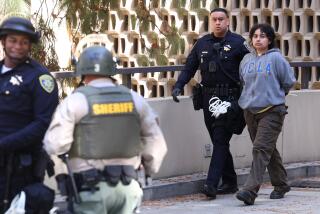They faced 66 years in prison. The ‘Eastside 13’ and how they helped plan the East L.A. walkouts

The day Eastside students marched for better schools and helped launch a movement.
- Share via
As Los Angeles schools and others this week observe the 50th anniversary of the East L.A. walkouts, when thousands of Mexican American students marched to demand a better education, much attention has focused on those who became known as the Eastside 13.
But who were the Eastside 13?
They were 13 men secretly indicted by a grand jury June 1, 1968, on conspiracy charges stemming from the East L.A. “blowouts.” The walkouts kicked off March 5, 1968, when students began protesting at Garfield High School, and spread to other campuses to decry the shortcomings of public schools in Los Angeles’ barrios. The walkouts are viewed as a turning point in the political development of the nation’s Mexican American community.
Some local leaders at the time, including Mayor Sam Yorty, denounced the walkouts as a communist plot, and in the months that followed, law enforcement responded with undercover operations, raids and arrests.
In returning the indictments, the grand jurors found there was sufficient evidence to show that the protests staged at Garfield, Lincoln, Roosevelt and Belmont high schools were not spontaneous, but rather the result of careful off-campus planning by non-students.
Defense attorneys would later argue, successfully, that the protest organizers were merely exercising their 1st Amendment rights. But when the indictments were handed down, each defendant faced 66 years in prison.
Among the 13 arrested was Carlos Muñoz Jr., who recalled how the police arrived at his apartment at dawn with guns drawn. Muñoz, then a 20-year-old college student, had been writing a paper for a graduate seminar on the “international communist movement” when the officers broke in.
One of the officers noticed a stack of books on the kitchen table where Muñoz had been typing. He scanned the names of the authors — Leon Trotsky, Vladimir Lenin and Karl Marx — and yelled out, “We’ve got the goods on this damn communist agitator!”
Also indicted on multiple charges of conspiracy to disturb public schools and conspiracy to disturb the peace were Sal Castro, 34, a teacher at Lincoln High, and Eliezer Risco, 31, a Cuban-born editor of La Raza, a newspaper circulated in the Mexican American community.
Indicted members of the militant Brown Berets, who often took the title of “minister,” were David Sanchez, 19, chairman; Ralph Ramirez, 18, minister of discipline; Fred Lopez, 19, minister of communication; and Carlos Montes, 20, minister of public relations and holy grace.
Others indicted were Gilberto Olmeda, 23; Richard Vigil, 27; Joe Razo, 29; Henry Gomez, 20; Moctesuma Esparza, 19; and Juan Sanchez, 41.
The indictments sparked protest marches in front of the Los Angeles Police Department’s downtown headquarters and the Justice Department in Washington. The American Civil Liberties Union branded the charges as a heavy-handed violation of the defendants’ constitutional rights to freedom of speech.
“We could hear outside of the jail thousands of people chanting — protesting our arrests. That made us feel that what we had done was worthwhile,” Esparza recalled.
Defense attorneys in the case included Oscar Acosta, a hell-raising lawyer with a gargantuan appetite for food, drugs and dangerous living who inspired the character of Dr. Gonzo in Hunter S. Thompson’s surreal book “Fear and Loathing in Las Vegas.”
“Oscar popped up out of nowhere offering to help,” David Sanchez recalled with a laugh. “I asked him once, ‘How’d you learn about us?’ He said he had been waiting on tables at a restaurant in Aspen, Colo., when he looked up at a television on the wall and saw news footage of Eastside kids being chased and beaten by police.
“Oscar said he took off his apron, threw it down on a table and announced, ‘Those people need a lawyer!’ Then he drove to L.A.”
Throughout the summer, Mexican American leaders urged the L.A. Board of Education to reinstate Castro, who had been removed from his job at Lincoln. Julian Nava, the only Mexican American on the school board, suggested a political motive for the arrests: They were made a few days before the June 4 municipal primary at which Dist. Atty. Evelle J. Younger was a candidate for reelection and a police bond issue was being submitted to voters.
RELATED: Do you remember the East L.A. walkouts? Share your memory. »
The indictments were struck down in 1970 by an appeals court in a case that became a cause celebre to Chicanos.
“The No. 1 thing that the walkouts achieved is that it gave our own community a voice — that we didn’t have to rely on what other people thought we should be doing or who we should be,” said Esparza, who went on to become an award-winning filmmaker, producing movies such as “Gettysburg,” “Selena” and “Walkout,” a dramatization of the 1968 Chicano student protests.
“I never gave up my identity as a Chicano,” Esparza said. “The struggle never ends.”
More to Read
Sign up for Essential California
The most important California stories and recommendations in your inbox every morning.
You may occasionally receive promotional content from the Los Angeles Times.











